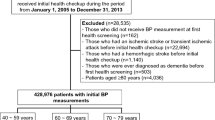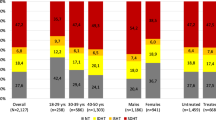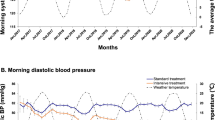Abstract
In the elderly, isolated systolic hypertension (ISH) is a particularly good predictor of subsequent cardiovascular events. The purpose of this article is to review the evidence provided by the Systolic Hypertension Elderly Program (SHEP) and the Systolic Hypertension in Europe Study (Syst-Eur) on the benefits of lowering systolic blood pressure (SBP) and to report on the preliminary findings of the Maracaibo Aging Study (MAS) on ISH. These two trials, the SHEP using chlorthalidone and atenolol as step 2 and the Syst-Eur using nitrendipine and hydrochlorothyazide as step 2, demonstrated a decrease of more than 30% for all cardiovascular complications, including stroke and coronary events. MAS is a population-based study that included all the subjects older than 55 years of age that resided in a defined area of the city of Maracaibo. There was a high prevalence of ISH (45.7%) being higher among women than in men, and significantly increased with advancing age. SBP was associated with dementia when it was measured by an ambulatory blood pressure monitor (ABPM), while there was no association when it was assessed by the casual method. Diastolic blood pressure (DBP) as casual or measured by ABPM was not related to dementia. In conclusion, ISH is a serious public health problem and benefits from lowering elevated SBP to reduce the risk of cardiovascular events. It was shown there was a strong correlation between high SBP and cognitive dysfunction and this was best demonstrated by using ABPM. Research should address the impact of using modern diagnostic tools and to compare the efficacy of the different types of antihypertensive drugs.
This is a preview of subscription content, access via your institution
Access options
Subscribe to this journal
Receive 12 digital issues and online access to articles
$119.00 per year
only $9.92 per issue
Buy this article
- Purchase on Springer Link
- Instant access to full article PDF
Prices may be subject to local taxes which are calculated during checkout
Similar content being viewed by others
References
Sagie A, Larson MG, Levy D . The natural history of borderline isolated systolic hypertension N Engl J Med 1993 329: 1912–1917
Joint National Committee on Prevention, Detection, Evaluation, and Treatment of High Blood Pressure. The Sixth Report of the joint National Committee, Detection, Evaluation, and Treatment of High Blood Pressure Arch Intern Med 1997 157: 2413–2446
Staessen J, Amery A, Fagard R . Isolated systolic hypertension in the elderly J Hypertens 1990 8: 393–405
Pahor M et al. Risk of gastrointestinal haemorrhage with calcium antagonists in hypertensives persons over 67 years old Lancet 1996 347: 1061–1065
Pahor M et al. Calcium-channel blockade and incidence of cancer in aged populations Lancet 1996 348: 493–497
SHEP Cooperative Research Group. Prevention of stroke by antihypertensive drug treatment in older persons with isolated systolic hypertension: final results of the systolic hypertension in the Elderly Program (SHEP) JAMA 1991 265: 3255–3264
Staessen JA et al. Randomised double-blind comparison of placebo and active treatment for olderpatients with isolated systolic hypertension Lancet 1997 350: 757–764
Collins R et al. Blood pressure, stroke and coronary heart disease, II: short-term reductions in blood pressure: overview of randomised drug trials in their epidemiological context Lancet 1990 335: 827–838
Hypertension Detection and Follow-up Program Cooperative Group. Five-years findings of the Hypertension Detection and Follow-up Program, III: reduction in stroke incidence among persons with high blood pressure JAMA 1982 247: 633–638
Hypertension Detection and Follow-up Program Cooperative Group. Effect of stepped care on the incidence of myocardial infarction and angina pectoris Hypertension 1984 6 (Suppl): 633–638
Swan G, Carnelli D, Larve A . Systolic blood pressure tracking over 25 to 30 years and cognitive performance in older adults Stroke 1998 29: 2334–2340
Launer L et al. The association between midlife blood pressure levels and late-life cognitive function. The Honolulu-Asia Aging Study JAMA 1995 274: 1846–1851
Seux M et al. Correlates of cognitive status of oldpatients with isolated systolic hypertension: The Syst-Eur Vascular Dementia Project J Hypertens 1998 16: 963–969
Forette F et al. Prevention of dementia in randomized double-blind placebo-controlled. Systolic Hypertension in Europe (Syst-Eur) trial Lancet 1998 352: 1347–1351
Folstein MF, Folstein SE, Mchugh PR . “Minimental State”: a practical method for grading the cognitive state ofpatients for the clinicians J Psychiat Res 1975 12: 189–198
Stern Y et al. Diagnosis of dementia in a heterogeneous population, development of a neuropsychological paradigm-based diagnosis of dementia and quantified correction for the effects of education Arch Neurol 1992 49: 453–460
Pittman J et al. Diagnosis of dementia in a heterogeneous population, a comparison of paradigm based diagnosis and physician diagnosis Arch Neurol 1992 49: 461–467
American Psychiatric Association. Diagnostic and Statistical Manual of Mental Disorders. 3rd edn. Revised Washington DC 1987
Farmer M et al. Blood pressure and cognitive performance. The Framinghan Study Am J Epidemiol 1987 126: 1103–1114
Glynn R et al. Current and remote blood pressure and cognitive decline JAMA 1999 281: 438–445
Kilander L et al. Hypertension is related to cognitive impairment: a 20-year follow-up of 999 men Hypertension 1998 31: 780–786
van Boxtel M et al. Can the blood pressure predict cognitive task performance in a healthy population sample? J Hypertens 1997 15: 1069–1076
Acknowledgements
We wish to thank MgSc Gloria Pino-Ramirez, and Dr Aldrin Molero for their contribution in the neuropsychological and neuropsychiatry testing of our patients and Dr Alicex González for processing part of the data.
Author information
Authors and Affiliations
Corresponding author
Additional information
Financial Support: The Maracaibo Aging Study is supported by CONICIT through grant G-97000726.
Rights and permissions
About this article
Cite this article
Sulbarán, T., Silva, E. & Maestre, G. Isolated systolic hypertension: a new challenge in medicine. J Hum Hypertens 16 (Suppl 1), S44–S47 (2002). https://doi.org/10.1038/sj.jhh.1001341
Published:
Issue Date:
DOI: https://doi.org/10.1038/sj.jhh.1001341
Keywords
This article is cited by
-
Prevalence of isolated systolic hypertension (ISH) in Slovene hypertensive patients: insights from the “Quality of Healthcare in Slovenia” project
Wiener klinische Wochenschrift (2015)
-
Potential surrogate markers of cerebral microvascular angiopathy in asymptomatic subjects at risk of stroke
European Radiology (2009)



